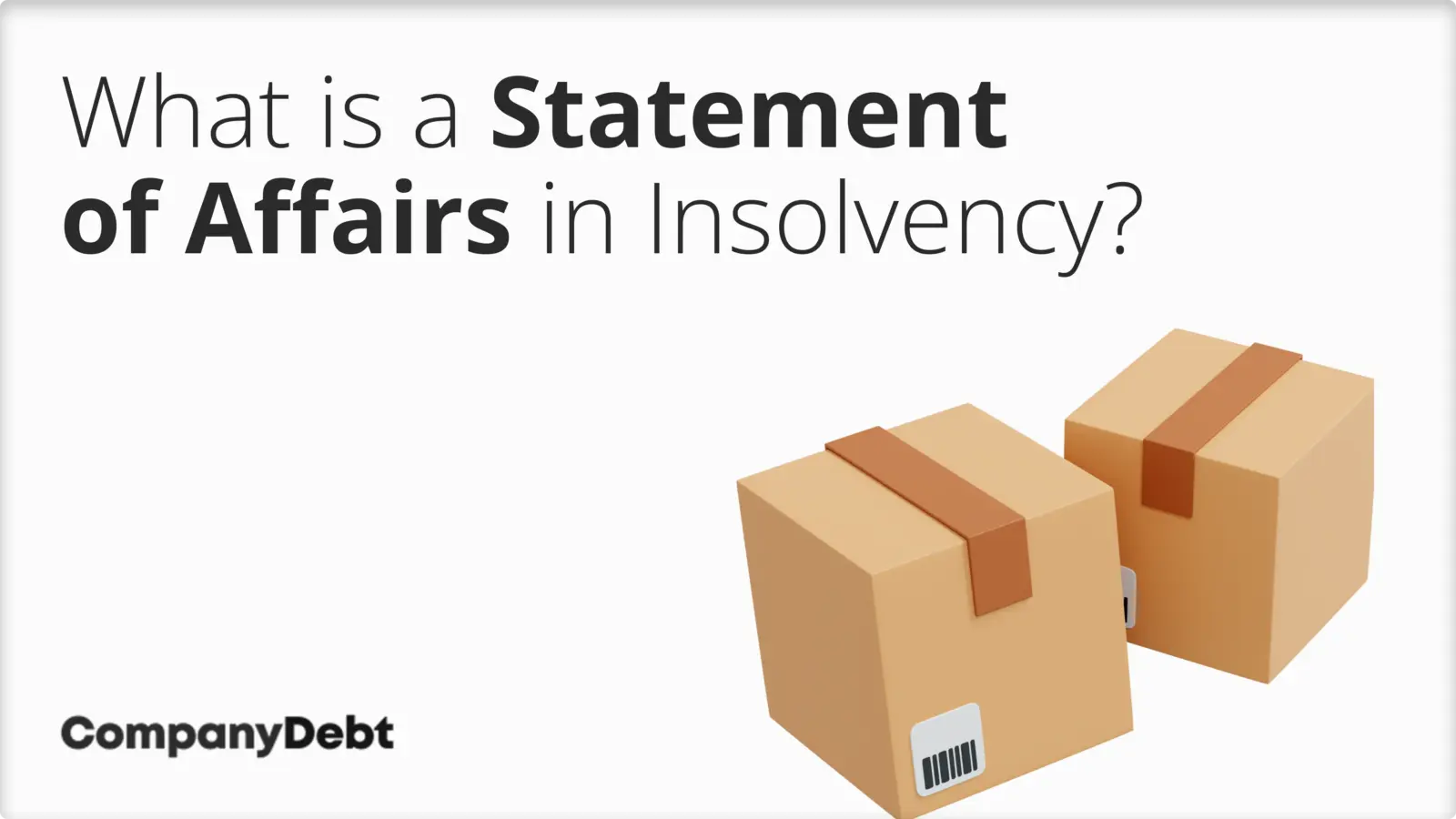
What’s a Statement of Affairs in Insolvency?
Learn about the purpose and content of a Statement of Affairs in insolvency proceedings and how it helps assess a company’s financial position.
- What’s a Statement of Affairs Document?
- What is Included in a Statement of Affairs?
- Which Insolvency Events Require an SOA?
- How is a Statement of Affairs Presented in Liquidation?
- What’s the Relevance of the SOA for the Investigations into Directors’ Conduct?
- What Happens if You Refuse to Produce an SOA?
- Help from Company Debt
- FAQs on Statement of Affairs
What’s a Statement of Affairs Document?
A statement of affairs is a financial document that provides a detailed snapshot of a business’s financial situation. It typically includes a list of assets, liabilities, and other relevant financial information.
While a statement of affairs can have other uses, in UK law, it is most commonly used to provide a concise summary of the corporate situation during insolvency events.
An SOA is prepared by the liquidator and must be verified by a statement of truth[1]Trusted Source – GOV.UK – Guidance on requiring and submission of statements of affairs and further accounts. It allows the Insolvency Practitioner to assess everything the company may own, including details of fixed or floating charges.
Once completed, the Statement of Affairs must be filed at Companies House by the Insolvency Practitioner. It’s intended first and foremost as a source of information for company creditors and shareholders, although potential buyers of the insolvency company will also find it useful.
Our expert business rescue & insolvency team can give you immediate advice about your situation, and the first consultation is always completely free. Click the live chat during working hours, or call 0800 074 6757, or tell us when you want to be called back here.

What is Included in a Statement of Affairs?
The SOA is a crucial step in insolvency procedures, so completing it correctly is necessary, and all the information must be accurate and true. You will need to provide full details, precise dates and amounts requested.
Here’s what a typical Statement of Affairs document will include:
- Basic Company Details: For companies, it includes the registered name, address, company number, and the names of directors.
- All assets owned by the individual or company. Assets are classified as either realisable or non-realisable. Realisable assets are those that can be converted into cash (e.g., property, vehicles, inventory, machinery, patents, investments, and cash in hand or in bank accounts). Non-realisable assets might include items that cannot be easily sold or are exempt from sale.
- Liabilities: This part details all the debts owed at the date of insolvency, including secured debts (e.g., mortgages, charges over assets), preferential debts (such as certain taxes and employee-related debts), unsecured debts (e.g., loans, credit cards, trade creditors), and contingent liabilities (potential debts that depend on a future event).
- Security Interests: Information on any assets that are subject to security interests (e.g., collateral for loans) and their estimated value.
- Deficiency Account: A summary that reconciles the assets and liabilities, showing the net deficit that remains after all assets have been accounted for against the liabilities.
- Book Debts: Details of any money owed to the insolvent entity by its customers or clients, if applicable.
- List of Creditors: This is a detailed list of creditors, including the nature of their claims, the amount owed, and any security held by them.
- Employees: Information on any outstanding payments due to employees, including wages, salaries, and redundancy payments.
- Director’s Loan Account: For companies, details of any loans to or from directors.
- Summary: A summary sheet that provides an overview of the total assets, claims, and the expected return to creditors.

The government provides a template for a Statement of Affairs (company winding-up), which you can find here [2]Trusted Source – GOV.UK – Rule 7.41 Statement of Affairs (company winding-up).
Which Insolvency Events Require an SOA?
The SOA document is used in the following insolvency events:
- Voluntary liquidation;
- Administration;
- Bankruptcy
- Individual voluntary arrangement (IVA)
- Company Voluntary Arrangements;
- Compulsory liquidation.
How is a Statement of Affairs Presented in Liquidation?
During voluntary liquidation, the Statement of Affairs is presented at the initial creditors’ or shareholders’ meeting, which must be held within 14 days of the liquidator’s appointment[2]Trusted Source – GOV.UK – Rule 7.41 Statement of Affairs (company winding-up).
For compulsory liquidation, the SOA is submitted to the liquidator or the Official Receiver early in the process, often before the first meeting of creditors. Legally, directors must submit the SOA to the official receiver within 21 days of the winding-up order being made.
The official receiver will then present the SOA to creditors at the initial creditors’ meeting, which must be held within 12 weeks of the winding-up order.
What’s the Relevance of the SOA for the Investigations into Directors’ Conduct?
One key function of the statement of affairs is to provide a transparent audit trail so that insolvency practitioners can establish whether assets were sold in the period preceding liquidation.
The liquidator or official receiver will analyse the SOA and compare it with the company’s records and other available information. Discrepancies or irregularities may point to potential offences committed by the directors, such as:
- Trading while insolvent
- Fraudulent trading
- Misfeasance or breach of fiduciary duties
- Falsification of company records
Where this is found to be the case, it can lead to a director’s disqualification in some instances.
>>Read our full article on the directors conduct report
What Happens if You Refuse to Produce an SOA?
In the case of failure to submit the SOA without a reasonable excuse, the nominated person is liable to a one-off fine of £5,000 and/or a daily default fine set by the court (£500).
Help from Company Debt
Company Debt is a leading firm of insolvency practitioners and company rescue experts based in North London.
Reach out to us via live chat, email us at info@companydebt.com, or give us a call at 0800 074 6757. The first consultation is always free, and we are happy to arrange a face-to-face meeting.
FAQs on Statement of Affairs
Can a Statement of Affairs be amended once submitted?
Yes, if errors are found or if additional information comes to light after the initial submission, amendments can be made with the approval of the insolvency practitioner overseeing the process.
Who has access to the Statement of Affairs once it’s filed?
The Statement of Affairs, once filed at Companies House, becomes a public document. Creditors, shareholders, and potential buyers of the insolvent company can access this information.
What role does the Statement of Affairs play in director investigations?
The Statement of Affairs helps insolvency practitioners trace the company’s financial movements and asset disposals.
What impact does a Statement of Affairs have on employees of an insolvent company?
It highlights any owed wages, redundancy pay, or other entitlements as liabilities, prioritising them in the order of repayment in line with insolvency regulations.
Are contingent liabilities included in a Statement of Affairs?
Yes, contingent liabilities, or debts that might become due based on future events, are included, providing a fuller picture of potential financial obligations.
The primary sources for this article are listed below, including the relevant laws and Acts which provide their legal basis.
You can learn more about our standards for producing accurate, unbiased content in our editorial policy here.
- Trusted Source – GOV.UK – Guidance on requiring and submission of statements of affairs and further accounts
- Trusted Source – GOV.UK – Rule 7.41 Statement of Affairs (company winding-up)






